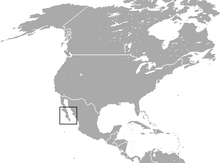San José brush rabbit
| San José brush rabbit | |
|---|---|
| Scientific classification | |
| Kingdom: | Animalia |
| Phylum: | Chordata |
| Class: | Mammalia |
| Order: | Lagomorpha |
| Family: | Leporidae |
| Genus: | Sylvilagus |
| Species: | S. mansuetus |
| Binomial name | |
| Sylvilagus mansuetus Nelson, 1907 | |
 | |
| San Jose brush rabbit range | |
The San José brush rabbit (Sylvilagus mansuetus) is a species of mammal in the family Leporidae.[2]
Distribution
It is endemic to the 170 km2 San José Island in the Gulf of California, a desert habitat island in the state of Baja California Sur in Mexico.[1] the island is only separated by a 5–8 km channel.[3] The rabbit only occurs on roughly 20 km2 with a population density estimated at 25-35 individuals per km2. This is the smallest known distribution of all lagomorph species.[4]
Conservation
The species has been recently uplisted to critically endangered on the IUCN Red List. This is due primarily to predation by feral cats, and are also effected by habitat loss, human developments and rats[3] and hunting which have all led to population declines since 1995/1996.[1] To preserve the species it has been recommended that the feral cats be removed and further research be conducted.[4] Although protected under Mexican law they are commonly poached by hunters legally hunting invasive goat species.[1]
Description
S. Mansuetus in the order Lagomorpha and family Leporidae,[1] is distinguishable from its relatives by its pallar pelag, larger ears and longer and more narrow skull. The winter pellageis bull yellow or yellow-grey with short black tips. The sided are pale and grey compared to its top pellage.[4] The species is closely related to Sylvilagus bachmani, which is found on the mainland Baja California Peninsula,[1] and was previously considered a subspecies of the latter by some authorities,[1][2] although new genetic evidence[5] has shown that it is the most genetically distinctive of S. Mansuetus S. Floridanus, S. Audubonii, S. Brasiliensis and Lepus californicus.
behavior
S. Mansuetus has been seen resting in the shade of trees on the island such as the Palo Verde.[1] The rabbit becomes reproductively active in November. Being crepuscular the rabbit is most active from sunset till 2am, adn 6am to 10am.[1] The San José Island is home to one of the most diverse mammalian populations of off islands in Baja California.[1] areas on the island rich in the plants; Fouquieria digueti, Jatropha cinerea, Pachicerus pringley, Opuntia cholla, B. microphylla, Simmondsia chinensis, Cercidium peninsulare, Stenocerus gummosus, Cyrtocarpa edulis, Esenbeckia flava, Lycium and Olneya tesota usually have the highest abundance of S. Mansuetus.[1].. The name Mansuetus is derived from Latin and means tame, regarding how close S. Mansuetus can be approached.[3]
Genealogy
S. Mansuetus was the first of the Sylvilagus species to branch off of Lepus californicus. Of all species in the genus Sylvilagus S. Mansuetus and S. audubonii have the largest genetic distance, although there ranges are very close together. It is also the most genetically distinctive of the rabbits in its genus.[5]
See also
- Fauna of Gulf of California islands
- Endemic fauna of Mexico
References
- 1 2 3 4 5 6 7 8 9 10 11 Lorenzo, C. & Álvarez-Castañeda, S. (2011). "Sylvilagus mansuetus". IUCN Red List of Threatened Species. Version 2011.2. International Union for Conservation of Nature. Retrieved 18 January 2012.
- 1 2 Hoffman, R.S.; Smith, A.T. (2005). "Order Lagomorpha". In Wilson, D.E.; Reeder, D.M. Mammal Species of the World: A Taxonomic and Geographic Reference (3rd ed.). Johns Hopkins University Press. p. 210. ISBN 978-0-8018-8221-0. OCLC 62265494.
- 1 2 3 "Thomas, Howard H., and Troy L. Best. "Sylvilagus Mansuetus." Mammalian Species, no. 464, 1994, pp. 1–2. www.jstor.org/stable/3504137.".
- 1 2 3 "Consuelo Lorenzo, Sergio Ticul Álvarez-Castañeda, and Jorge Vázquez Western North American Naturalist Apr 2011 : Vol. 71, Issue 1, pg(s) 10-16 doi: 10.3398/064.071.0102".
- 1 2 "Cervantes, F. A., J. P. Ramirez-Silva, and L. Gloria. "Allozyme variation of cottontail rabbits (Sylvilagus) from Mexico." Zeitschrift fur Saugetierkunde64.6 (1999): 356-362.".
